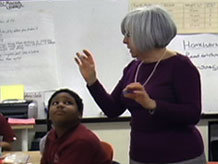How can we measure the volumes of rocks?
1. Ask the question

Meet in a circle and show students the two rocks or minerals.
- Which rock has the greater volume? How much greater?
Listen to the students’ comparisons. Do they distinguish weight from volume? Can they express relative volume ("This one is twice as big"; "That one has less stuff in it"?) Do they remember the correct unit of measure — cubic centimeters? Do they suggest submerging the rocks in water to find out? (If yes, tell them to "Hold that thought!") As you field the comments, encourage students to think about a quantitative comparison:
Weight vs. volume: Fourth graders sometimes have difficulty distinguishing weight and volume. If you hear this confusion entering the discussion, stop and ask, "Are you talking about weight or volume? If this rock were made of Styrofoam or feathers instead of minerals, would its volume be any different? No, volume is the amount of space the rock takes up, not how much it weighs."
- What if we want to know exactly how much greater, how could we figure that out?
Estimating volume: Thinking about how much space objects take up can sometimes be easier when we see those objects enclosed in defined spaces — like a plastic container. If students are having difficulty imagining solid volumes, take a moment to practice estimation skills.
Place each of the three demonstration blocks inside an empty 150cc container, one at a time, starting with the largest. Ask, "How many more of these 20cc [12 cc, 1cc] blocks do you think can fit into this container?" Four to six 20cc blocks will fit comfortably in the container, and it will hold more than six 12cc blocks.
You might also measure the volumes of some small, common classroom objects before class, and make them available for reference during the demonstration.
Draw attention to the investigation question:
How can we measure the volumes of rocks?
Let students brainstorm some ideas. Entertain all ideas for now.
Bring out the three blocks — the 1cc cube, the 12cc block, and the 20cc block — and pass them around. Ask students to inspect each one carefully, looking from all sides and counting the number of centimeter cubes, then ask for the volume of each object (1cc, 12cc, 20cc).
Volume vs. surface area: Fourth graders will sometimes confuse volume with surface area, counting the two-dimensional "faces" of the cubes on the outside of the block instead of the three-dimensional cubes that make up its volume. Model the three-dimensional space with your hands or take one of the blocks apart, count the individual cubes with the class, then tape the cubes back together again.
Bring out the volume line and ask a volunteer to place the three blocks on the line. Point out that the volume line is just like a weight line, e.g. it starts at zero and has even intervals of measure, but it is marked in cubic centimeters and is used to compare the volumes of objects. Ask volunteers to place the two rocks on the volume line where they estimate they should go.
Does the volume line help us to see any more information about how the volumes of the objects compare?
Sum up the work so far. Students have estimated the volume of the two rocks using their eyes and three reference blocks. But they still don't have a measured volume.
Can we get any closer to the actual volumes of the two rocks? Is there any way we can use our centimeter cubes to help us?
Demonstrate how to estimate the volume of a rock by replicating its size and shape with a pile of centimeter cubes. Then, place two 150cc containers, approximately half full of water, side by side with the cubes in front of one container and the rock in front of the other.
If we want to find out if this replica has the same volume as the rock, what could we do?
Listen for ideas about water displacement and settle on a procedure like this one:
- Equalize the amount of water in the two containers, using the pipette
- Place the rock in one container and add the cubes to the second container, counting as you go, until the water levels are the same.



